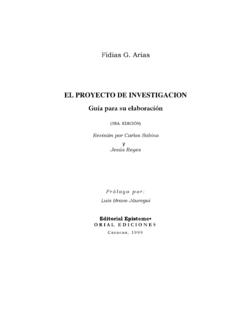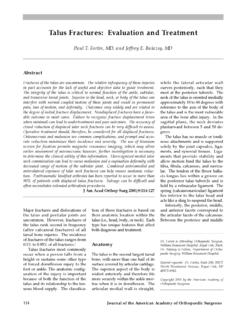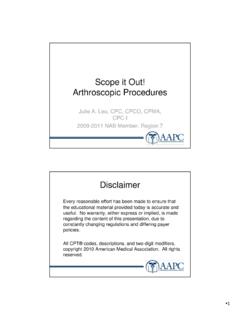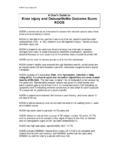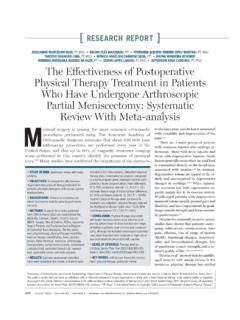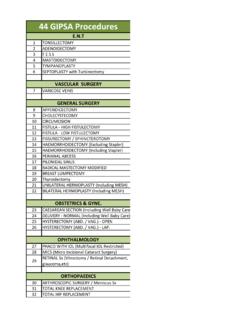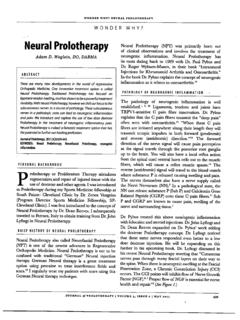Transcription of The Multiple-Ligament Injured Knee: Evaluation, …
1 Current ConceptsThe Multiple-Ligament Injured knee : evaluation , Treatment,and ResultsGregory C. Fanelli, , Daniel R. Orcutt, , , and Craig J. Edson, , , :The Multiple-Ligament Injured knee is a complex problem in orthopaedic surgery. Mostdislocated knees involve tears of the anterior and posterior cruciate ligaments (ACL/PCL) and at least1 collateral ligament complex. Careful assessment of the extremity vascular status is essentialbecause of the possibility of arterial and/or venous compromise. These complex injuries require asystematic approach to evaluation and treatment.
2 Physical examination and imaging studies enablethe surgeon to make a correct diagnosis and to formulate a treatment plan. Arthroscopically assistedcombined ACL/PCL reconstruction is a reproducible procedure. knee stability is improved postop-eratively when evaluated using knee ligament rating scales, arthrometer testing, and stress radio-graphic analysis. Acute medial collateral ligament (MCL) tears, when combined with ACL/PCLtears, may in certain cases be treated with bracing. Posterolateral corner injuries combined withACL/PCL tears are best treated with primary repair as indicated, combined with reconstruction usinga post of strong autograft (split biceps tendon, biceps tendon, semitendinosus) or allograft (Achillestendon, bone patellar tendon bone) tissue.
3 Surgical timing depends on the ligaments Injured , thevascular status of the extremity, reduction stability, and the overall health of the patient. We preferto use allograft tissue for reconstruction in these cases because of the strength of these large graftsand the absence of donor site Words:Dislocated knee Combined ACL/PCLinjury Allograft Arthroscopic dislocated knee is a severe injury resultingfrom violent trauma. It results in disruption of atleast 3 of the 4 major ligaments of the knee and leadsto significant functional instability. Vascular andnerve damage, as well as associated fractures, maycontribute to the challenge of caring for this treatment was primarily limited to immobi-lization.
4 However, with the advent of better surgicalinstrumentation and technique, the management ofcombined anterior and posterior cruciate ligament (ACL/PCL) tears associated with medial or lateralcollateral ligament (MCL/LCL) disruption has be-come primarily surgical. This article presents the basicknee anatomy, mechanisms and classifications of in-jury, evaluation , treatment, postoperative rehabilita-tion, and our experience with treating the stability of the knee is attributable to severalanatomic structures. The articulation of the femo-rotibial joint is maintained in part by the bony anat-omy of the femoral condyles and the tibial menisci serve to increase the contact area betweenfemur and tibia and thus increase stability of the 4 major ligaments (ACL, PCL, MCL, LCL) andthe posterior medial and posterior lateral corners arethe most significant ligamentous stabilizers of theknee.
5 In addition to these static anatomic structures,From the Department of Orthopaedic Surgery, Geisinger Med-ical Center, Danville, Pennsylvania, correspondence and reprint requests to Gregory , , Geisinger Medical Center, 100 North Academy Rd,Danville, PA 17822-2130, E-mail: 2005 by the Arthroscopy Association of North America0749-8063/05/2104-4123$ : The Journal of Arthroscopic and Related Surgery, Vol 21, No 4 (April), 2005: pp 471-486dynamic anatomic structures, such as the musculaturethat crosses the knee joint, also play a role in stabili-zation. In any knee injury, examination must includeevaluation of all these anatomic evaluating a dislocated knee , it is imperativeto evaluate the structural integrity of any remainingligamentous structure; consequently, the functions ofthese structures must be well understood.
6 The ACLprimarily prevents anterior translation of the tibia rel-ative to the femur, and accounts for about 86% of thetotal resistance to anterior tibial is alsoinvolved in limiting internal and external rotation ofthe tibia relative to the femur when the knee is ACL will also limit varus and valgusstress in the face of either an LCL or an MCL PCL may be considered the primary staticstabilizer of the knee , given its location near the centerof rotation of the knee and its relative has been shown to provide 95% of the totalrestraint to posterior tibial displacement forces actingon the PCL works in concert with struc-tures of the posterior lateral corner, and injury to bothstructures is required to significantly increase poste-rior MCL and LCL act alone to resist valgus andvarus stresses, respectively, at 30 of knee , they act in a secondary fashion to limitanterior and posterior translation.
7 And rotation of thetibia on the femur. The anatomy of the posteriorlateral corner of the knee is complex; its major struc-tures consists of (1) the LCL, (2) the arcurate com-plex, (3) the popliteal tendon, and (4) the popliteal-fibular posterolateral corner primarilyresists posterior lateral rotation of the tibia relative tothe femur, but also contributes to resisting posteriortibial translation. The posteromedial corner of theknee consists primarily of the posterior oblique por-tion of the MCL and associated joint capsule. Thesestructures provide resistance to valgus stress and pos-terior medial tibial translation.
8 evaluation of traumaticknee dislocation must include these anatomic struc-tures; typically, 3 or more areas are Injured in kneedislocation. Failure to recognize and treat capsular andligamentous injury, aside from the obvious ACL/PCLinjury, will result in less than optimal structures are also at risk of popliteal fossa is defined by the tendons of the pesanserinus and semimembranous medially and the bi-ceps tendon laterally. The space is closed distally bythe medial and lateral heads of the gastrocnemius andproximally by the hamstrings. Within this space, thepopliteal artery and vein and the tibial and peronealbranches of the sciatic nerve are located.
9 The poplitealartery may be most at risk to injury in knee disloca-tions. The popliteal artery is tethered proximally at theadductor hiatus as it exits from Hunter s canal, anddistally as it passes under the soleus arch, making itvulnerable to injury in these areas. This artery isconsidered to be an end artery of the lower limb; ifit is Injured , the surrounding geniculate arteries are notsufficient to maintain collateral blood flow to thelower extremity. The popliteal vein is in close asso-ciation with the artery, but seems to be less at riskduring injury than the popliteal artery.
10 From a surgicalstandpoint, the popliteal vessels are located directlyposterior to the posterior horns of the medial andlateral meniscus, and dissection in this area may putthese structures at risk if not adequately protected. Thesciatic nerve divides into its peroneal and tibial divi-sions within the popliteal space. These nerves are lesslikely to be Injured with knee dislocation, probablybecause they are not tethered as the popliteal artery peroneal nerve is at higher risk because its coursearound the fibular head functionally decreases its po-tential excursion, and violent varus injuries may resultin traction and/or avulsion injuries to this nerve.
